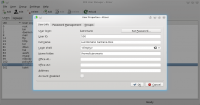Scratchpad/www-rework/Batch1
Module kdeaccessibility
kmag
Screenshot sent:
Name: Kmag (KMagnifier)
Description:
KMagnifier (or kmag, its unix name) is a small utility for Linux to magnify a part of the screen. It was initially written for KDE 1, before becoming dormant. The development was then picked up by me and KMagnifier got its new life. It is currently being maintained/developed actively. KMagnifier is very useful for people with visual disabilities and for those working in the fields of image analysis, web development etc.
Features (optional):
Homepage: http://kmag.sourceforge.net/
ID on kde-apps.org:
Page on Userbase:
ID of subforum on forum.kde.org:
Link to handbook: http://kmag.sourceforge.net/doc.html
IRC channel(s):
Mailing lists:
Project name on cia.vc:
Bugzilla component:
kmousetool
Screenshot sent:
Name: KMouseTool
Description: KMouseTool is a Linux-based KDE program. It clicks the mouse for you, so you don't have to. KMouseTool works with any mouse or pointing device.
Features:
Clicking Dragging
Homepage: http://accessibility.kde.org/aids/kmousetool.php
ID on kde-apps.org:
Page on Userbase: http://accessibility.kde.org/aids/kmousetool.php
ID of subforum on forum.kde.org:
Link to handbook:
IRC channel(s):
Mailing lists:
Project name on cia.vc:
Bugzilla component:
kmouth
Screenshot sent:
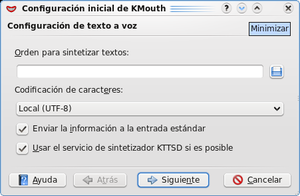
Name: KMouth
Description: [can be HTML or wiki markup]
KMouth is a program which enables persons that cannot speak to let their computer speak, e.g. mutal people or people who have lost their voice. It has a text input field and speaks the sentences that you enter. It also has support for user defined phrasebooks.
Features (optional):
Homepage: http://www.schmi-dt.de/kmouth/index.en.html
ID on kde-apps.org: none
Page on Userbase: http://userbase.kde.org/Kmouth [empty]
ID of subforum on forum.kde.org: 22
Link to handbook: http://docs.kde.org/stable/en/kdeaccessibility/kmouth/index.html
IRC channel(s): #kde-accessibility
Mailing lists: https://mail.kde.org/mailman/listinfo/kde-accesibility
Project name on cia.vc: kde/kmouth
Bugzilla component:
ksayit
ktts
Screenshot sent: Name:KTTS
Description: KTTS -- KDE Text-to-Speech -- is a subsystem within the KDE desktop for conversion of text to audible speech. KTTS is currently under development and aims to become the standard subsystem for all KDE applications to provide speech output.
User Features:
Speak any text from the KDE clipboard. Speak any plain text file. Speak all or any portion of a text file from Kate, including instances where Kate is embedded in another KDE application. Speak all or any portion of an HTML page from Konqueror. Use as the speech backend for KMouth and KSayIt. Speak KDE notifications (KNotify). Long text is parsed into sentences. User may backup by sentence or paragraph, replay, pause, and stop playing. Audio output via aRts, GStreamer (version 0.8.7 or later), or aKode. User-configurable filters for substituting misspoken words, choosing speech synthesizers, and transforming XHMTL/XML documents.
Programmer Features
Priority system for screen reader outputs, warnings and messages, while still playing regular texts. Plugin-based architecture for support of a wide variety of speech synthesis engines and drivers. Permit generation of speech from the command line (or via shell scripts) using the KDE DCOP utilities. Provide a lightweight and easily usable interface for applications to generate speech output. Applications need not be concerned about contention over the speech device. FUTURE: Provide support for speech markup languages, such as VoiceXML, Sable, Java Speech Markup Language (JSML), and Speech Markup Meta-language (SMML). FUTURE: Provide limited support for embedded speech markers. Asynchronous to prevent system blocking.
Homepage: http://accessibility.kde.org/developer/kttsd/
ID on kde-apps.org: 18806
Page on Userbase: http://accessibility.kde.org/developer/kttsd/
ID of subforum on forum.kde.org:
Link to handbook: http://docs.kde.org/development/en/kdeaccessibility/kttsd/index.html
IRC channel(s): #kde-accessibility
Mailing lists: https://mail.kde.org/mailman/listinfo/kde-accessibility
Project name on cia.vc:
Bugzilla component:
Module kdeadmin
kcron
kdat
knetworkconf
ksystemlog
ksysv
kuser
Screenshot sent:
Name: Kuser
Description: KUser is a tool that helps the system adminstrator to manage the system's users and groups.
Features (optional):
- User and group creation and edition
- Easy password and group management for each user
Homepage: No
ID on kde-apps.org: No
Page on Userbase: KUser
ID of subforum on forum.kde.org: No
Link to handbook: The KUser handbook
IRC channel(s): No
Mailing lists: No
Project name on cia.vc: kuser
Bugzilla component:
Module kdebase
dolphin
Screenshot sent:
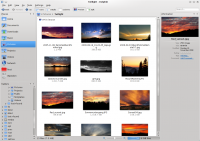
Name: Dolphin
Description: (can be HTML or wiki markup)
Dolphin is a lightweight file manager part of the KDE Software Collection of applications. It has been designed with ease of use and simplicity in mind, while still allowing flexibility and customisation. This means that you can do your file management exactly the way you want to do it.
Features (optional):
- Navigation Bar
Dolphin features a navigation (or breadcrumb) bar for URLs, allowing you to quickly navigate through the hierarchy of files and folders.
- View Styles and Properties
Dolphin supports several different kinds of view styles and properties and allows you to configure the view exactly how you want it.
- Split Views
Dolphin supports a split view, allowing you to easily copy or move files between locations.
- Dockable Panels
Additional information and shortcuts are available as dock-able panels, allowing you to move them around freely and display exactly what you want.
- Other features:
- Multiple tab support
- Informational dialogues are displayed in an unobtrusive way.
- Undo/redo support
- Transparent network access through the KIO system.
Homepage: http://dolphin.kde.org
ID on kde-apps.org: n/a
Page on Userbase: http://userbase.kde.org/Dolphin
ID of subforum on forum.kde.org: 66 (Workspace forum)
Link to handbook: http://docs.kde.org/stable/en/kdebase-apps/dolphin/index.html
IRC channel(s):
Mailing lists:
Project name on cia.vc: http://cia.vc/stats/project/kde/dolphin
Bugzilla component: dolphin
kappfinder
kdepasswd
Screenshot sent:

Name: kdepasswd
Description: kdepasswd is a graphical tool to change the password of the current user, similar to the command-line tool passwd.
Features (optional):
ID on kde-apps.org: No
Page on Userbase: No
ID of subforum on forum.kde.org: No
Link to handbook: No
IRC channel(s): No
Mailing lists: No
Project name on cia.vc: No
Bugzilla component:
kdialog
Screenshot sent: no
Name: Kdialog
Description: [can be HTML or wiki markup]
Kdialog allows you to display dialog boxes from shell scripts. The syntax is very much inspired from the "dialog" command (which shows text mode dialogs).
Features (optional):
Homepage:
ID on kde-apps.org: [none]
Page on Userbase: [empty]
ID of subforum on forum.kde.org: 108
Link to handbook:
http://techbase.kde.org/Development/Tutorials/Shell_Scripting_with_KDE_Dialogs
IRC channel(s):
Mailing lists:
Project name on cia.vc:
Bugzilla component: general
keditbookmarks
kfind
kinfocenter
konqueror
konsole
kwrite
Screenshot sent:
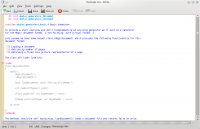
Name: KWrite
Description: KWrite is a text editor for KDE, based on the Kate's editor component.
Features (optional):
- Syntax highlighting according to the file type
- Word completion
- Auto-identation
- Plugin support
- Vi input mode
Homepage: About KWrite | Kate
ID on kde-apps.org: 9901
Page on Userbase: KWrite
ID of subforum on forum.kde.org: No
Link to handbook: The KWrite Handbook
IRC channel(s): [email protected]
Mailing lists: KWrite-Devel Info Page
Project name on cia.vc: kwrite (probably not active)
Bugzilla component:
Module kdeedu
blinken
cantor
Name: Cantor
Screenshot sent:
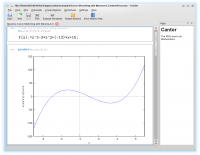
Description:
Cantor is a front-end to powerful mathematics and statistics packages. Cantor integrates them into into the KDE Platform and provides a nice, worksheet-based, graphical user interface.
Features:
- Support for four different environments (Maxima, R, SAGE, KAlgebra)
- Possibility to retrieve and share worksheets through Get Hot New Stuff
- Integration of the selected environment's help in the user interface
Homepage: http://edu.kde.org/cantor
ID on kde-apps.org: none
Page on Userbase: [empty]
ID of subforum on forum.kde.org: 21
Link to handbook: http://docs.kde.org/development/en/kdeedu/cantor/index.html
IRC channel(s): #kde-edu
Mailing lists: [email protected]
Project name on cia.vc: kde/cantor
Bugzilla component: cantor
kalgebra
kalzium
Screenshot sent: yes, but german language
Name: Kalzium
Description: Kalzium is your digital replacement for the periodic
table on paper. Is a program that visualizes the Periodic Table of Elements
(PSE) and includes basic information about all common elements in the PSE. It
has a gained much more functions over time.
It has the following features:
- versatile overview of all important data from the elements like melting points, electron affinity, electron negativity, electron configuration, radii, mass, ionisation energy
- tool to visualize the spectral lines of each elements
- different colored views to the PSE: separation of the different blocks, Year simulator, Temperature simulator
- Molecular weight calculator
- an Isotopetable
- a 3D molecule editor, with a load and save functionality
- a equation solver for stoichiometric problems
- filetype conversion for different types of chemical programs
- tool to produce a comprehesive list of all Risk_and_Safety_Statements
Features (optional):
Homepage: http://edu.kde.org/kalzium/
ID on kde-apps.org: 11224
Page on Userbase: http://userbase.kde.org/Applications/Education#Science
ID of subforum on forum.kde.org:
Link to handbook: http://docs.kde.org/stable/en/kdeedu/kalzium/
IRC channel(s): #kalzium or #kde-edu
Mailing lists: [email protected]
Project name on cia.vc: KDE/Kalzium
Bugzilla component: kalzium
kanagram
kbruch
kgeography
khangman
kig
kiten
klettres
kmplot
Screenshot sent:

Name: KmPlot
Description:
KmPlot is a program to draw graphs, theit integrals or their derivations. It supports different systems of coordinates like the carthesic or the polar system. The graphs can be colorized and the view is scalable, so that you are able to zoom to the level you need.
Features (optional): please add features-section
Homepage: http://edu.kde.org/kmplot/
ID on kde-apps.org: none
Page on Userbase: http://edu.kde.org/kmplot/
ID of subforum on forum.kde.org: 21
Link to handbook: http://docs.kde.org/stable/en/kdeedu/kmplot/index.html
IRC channel(s): #kde-edu
Mailing lists: [email protected]
Project name on cia.vc: kde/kmplot
Bugzilla component: kmplot
kstars
Screenshot sent:

Name: KStars
Description: [can be HTML or wiki markup]
KStars is a Desktop Planetarium for KDE. It provides an accurate graphical simulation of the night sky, from any location on Earth, at any date and time. The display includes upto 100 million stars, 13,000 deep-sky objects,all 8 planets, the Sun and Moon, and thousands of comets and asteroids.
Features (optional):
Catalogs:
- Default catalog consisting of stars to magnitude 8
- Extra catalogs consisting of 100 million stars to magnitude 16
- Downloadable catalogs including Messier Images, Abell Planetary Nebulae
- Corrections for precession, nutation and atmospheric refraction
- Tools for retrieval of data from Online Databases
- Scriptable actions using D-Bus
- Integration with INDI provides support for a wide range of instruments
Features for Educators and Students:
- Adjustable simulation speed in order to view phenomena that happen over long timescales
- KStars Astrocalculator to access some of the internal calculations of KStars, and also to predict conjunctions etc
- Astroinfo project to help facilitate learning with the aid of KStars
- Internet links for further information / pictures of objects
Features for Amateur Astronomers:
- Observing List tool to plan observations
- FOV Editor helps calculate field of view of equipment and display them
- Obtain AAVSO light curves for variable stars
- What's up tonight tool
- Altitude vs Time tool
- Sky Calendar tool
Homepage: http://edu.kde.org/kstars/
ID on kde-apps.org: 9862
Page on Userbase: http://userbase.kde.org/KStars
ID of subforum on forum.kde.org: 21
Link to handbook: http://docs.kde.org/stable/en/kdeedu/kstars/index.html
IRC channel(s): #kde-edu
Mailing lists: [email protected], [email protected]
Project name on cia.vc: KDE/kstars
Bugzilla component:
ktouch
kturtle
kwordquiz
marble
Screenshot sent:
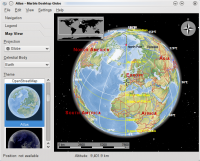
Name: Marble
Description: (can be HTML or wiki markup)
Marble is a Virtual Globe and World Atlas that you can use to learn more about Earth: You can pan and zoom around and you can look up places and roads. A mouse click on a place label will provide the respective Wikipedia article.
Of course it's also possible to measure distances between locations or watch the current cloud cover. Marble offers different thematic maps: A classroom-style topographic map, a satellite view, street map, earth at night and temperature and precipitation maps. All maps include a custom map key, so it can also be used as an educational tool for use in class-rooms. For educational purposes you can also change date and time and watch how the starry sky and the twilight zone on the map change.
In opposite to other virtual globes Marble also features multiple projections: Choose between a Flat Map ("Plate carré"), Mercator or the Globe.
The best of all: Marble is Free Software / Open Source Software and promotes the usage of free maps. And it's available for all major operating systems (Linux/Unix, MS Windows and Mac OS X).
Features (optional):
Homepage: http://edu.kde.org/marble/
ID on kde-apps.org: 55105
Page on Userbase:
ID of subforum on forum.kde.org: 21
Link to handbook: http://docs.kde.org/stable/en/kdeedu/marble/index.html
IRC channel(s): #marble (and #kde-edu)
Mailing lists: [email protected] and [email protected]
Project name on cia.vc: Marble
Bugzilla component: marble
parley
Screenshot sent:
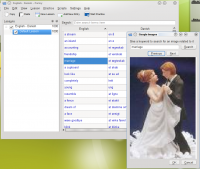
Name: Parley
Description: [can be HTML or wiki markup]
Parley is a program to help you memorize things.
Parley supports many language specific features but can be used for other learning tasks just as well. It uses the <a href=\"http://en.wikipedia.org/wiki/Spaced_repetition\">spaced repetition</a> learning method, also known as flash cards.
Creating new vocabulary collections with Parley is easy, but of course it is even better if you can use some of our premade files. Have a look at the <a href=\"http://kde-files.org/index.php?xcontentmode=687\">KDE-Files.org</a> page or use the \"Download New Collections\" feature directly.
Features (optional):
Different test types
Mixed Letters (order the letters, anagram like) to get to know new words
Multiple choice
Written tests - type the words (including clever correction mechanisms)
Example sentences can be used to create 'fill in the gap' tests
Article training
Comparison forms (adjectives and/or adverbs)
Conjugations
Synonym/Antonym/Paraphrase
Fast test setup with all options in one dialog
More than two languages (for example English, Chinese Traditional and Chinese Simplified)
Find words (also by word type) quickly
Easy lesson management
Premade vocabulary files ready to use
Share and download vocabulary using Get Hot New Stuff
Open XML file format (shared with KWordQuiz, Kanagram and KHangMan) that can be edited by hand and is easily usable with scripts
Homepage: http://edu.kde.org/parley
ID on kde-apps.org: 66741
Page on Userbase: [empty]
ID of subforum on forum.kde.org: 21
Link to handbook: http://docs.kde.org/stable/en/kdeedu/parley/index.html
IRC channel(s): #kde-edu
Mailing lists: [email protected], [email protected]
Project name on cia.vc: kde/parley
Bugzilla component: parley
rocs
Screenshoot sent: Yes.
Name: Rocs
Description:Rocs is an IDE For Graph Theory that can help studants to implement the Graph Algorithms and see te visual representation of the result, and such is a nice tool to have in Computer Related classes.
Features:
- Canvas for Graph Drawing
- IDE for Graph relatedd Programming, using Javascript as it's main laguage, plus the graph library
- Nodes, Graphs and Edges are extensible from the scripting interface, so you can do anything you want.
Homepage: http://edu.kde.org/rocs/
ID on kde-apps.org: 118706
Page on Userbase: http://userbase.kde.org/Applications/Education#Science
ID of subforum on forum.kde.org:
Link to handbook:
IRC channel(s): #kde-edu
Mailing lists: kde-edu mailing list
Project name on cia.vc:
Bugzilla component: rocs
step
Module kdegames
bomber
bovo
granatier
kapman
katomic
kbattleship
kblackbox
kblocks
kbounce
kbreakout
kdiamond
kfourinline
kgoldrunner
kigo
Screenshot sent: [1]
Name: Kigo Description: Go boardgame for KDE Kigo is an open-source implementation of the popular Go game (also known as Weiqi). Go is a strategic board game for two players. It is also known as igo (Japanese), weiqi or wei ch'i (Chinese) or baduk (Korean). Go is noted for being rich in strategic complexity despite its simple rules. The game is played by two players who alternately place black and white stones (playing pieces, now usually made of glass or plastic) on the vacant intersections of a grid of 19x19 lines (9x9 or 13x13 for easier games).
Features (optional): Themeable, GHNS Homepage: [2] ID on kde-apps.org: none Page on Userbase: none ID of subforum on forum.kde.org: 21 Link to handbook: [3] IRC channel(s): #kdegames Mailing lists: [email protected] Project name on cia.vc: KDE/kigo Bugzilla component: kigo
killbots
kiriki
kjumpingcube
klines
kmahjongg
kmines
knetwalk
Screenshot sent:
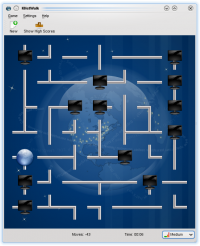
Name: KNetWalk
Description: KNetWalk is a small game where you have to build up a computer-network by putting the rigth wires into the right order. When the network is build, a highscore-list comes up where competitions can be fought out.
Features (optional): add features section
Homepage: http://games.kde.org/game.php?game=knetwalk
ID on kde-apps.org: none
Page on Userbase: [empty]
ID of subforum on forum.kde.org: 21
Link to handbook: http://docs.kde.org/stable/en/kdegames/knetwalk/index.html
IRC channel(s): #kdegames
Mailing lists: [email protected]
Project name on cia.vc: kde/knetwalk
Bugzilla component: knetwalk

